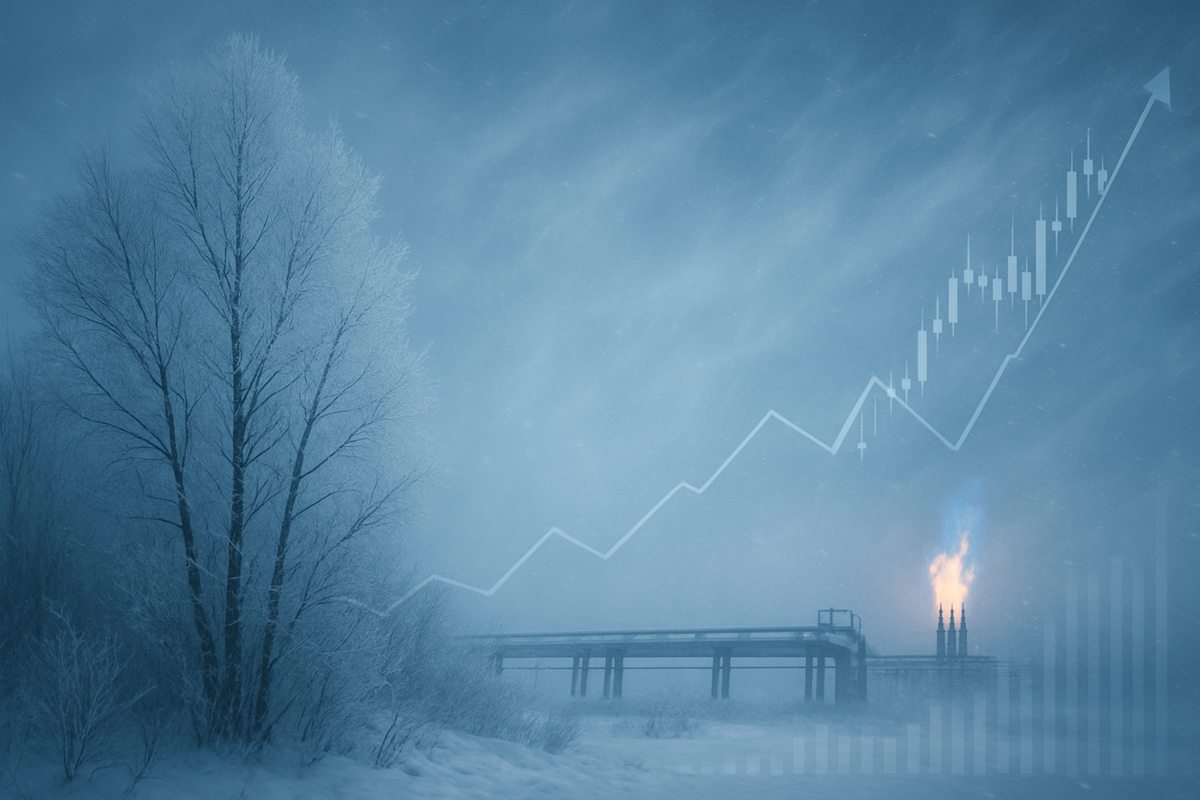
Natural gas futures are experiencing a significant uptick as colder weather forecasts sweep across key consumption regions, signaling an early and potentially intense start to the heating season. This surge reflects immediate market reactions to anticipated spikes in demand, putting upward pressure on prices and setting a bullish tone for the energy sector. The shift in meteorological outlook has galvanized traders and analysts, who are now closely monitoring weather patterns and storage levels for further cues on price direction.
This meteorological turn of events, particularly in late September 2025, has sent ripples through the energy markets, highlighting the profound sensitivity of natural gas prices to atmospheric conditions. As the prospect of increased heating demand becomes more concrete, the intricate balance between supply, demand, and storage is once again at the forefront of financial discussions, with implications for both energy producers and consumers.
The Chill Arrives: Unpacking the Natural Gas Price Rally
The recent climb in natural gas futures is directly attributable to updated weather models predicting colder-than-normal temperatures across substantial portions of the United States, particularly the Eastern U.S. and parts of the Midwest, well into October. This forecast has led to a re-evaluation of expected natural gas demand for heating, prompting a rush among market participants to secure supplies. For instance, November Nymex natural gas prices (NYMEX: NGX25) rallied to a 2.25-month high in late September 2025, driven by these colder outlooks.
Historically, September is a critical month for natural gas as inventories are built up in preparation for winter. Colder forecasts at this juncture signal an accelerated drawdown from these storage levels, raising concerns about potential supply tightness later in the season. While U.S. natural gas inventories as of September 19, 2025, were reported to be up 0.5% year-over-year and 6.1% above their five-year seasonal average, the anticipation of rapid depletion due to early cold snaps is a primary factor fueling the current price surge. Key players involved are primarily natural gas producers, utility companies, and energy traders who are adjusting their positions in response to the changing demand outlook.
The immediate market reaction has been a strong bullish sentiment, with increased buying activity in prompt-month futures contracts. This volatility underscores how quickly the market can pivot based on weather projections, which are often considered the most significant short-term driver of natural gas prices. Beyond domestic consumption, global factors, such as robust demand for U.S. Liquefied Natural Gas (LNG) exports, also contribute to the overall supply-demand dynamics, adding another layer of complexity to price formation.
Winners and Losers: Corporate Implications of a Colder Outlook
The sudden shift to colder weather forecasts presents a clear dichotomy of potential winners and losers among public companies operating within the energy sector. Natural gas producers stand to be primary beneficiaries. Companies like EQT Corporation (NYSE: EQT), Chesapeake Energy (NASDAQ: CHK), and Southwestern Energy (NYSE: SWN) could see increased revenues as higher natural gas prices translate directly into fatter profit margins for their extracted gas. With robust production levels already near record highs, these companies are well-positioned to capitalize on elevated demand, assuming their infrastructure can handle increased output without significant disruptions. Their stock prices often react positively to sustained periods of higher commodity prices.
Conversely, energy-intensive industries and utility companies that rely heavily on natural gas for power generation or heating could face increased operational costs. Large utility providers such as Consolidated Edison (NYSE: ED) or PG&E Corporation (NYSE: PCG), while often able to pass on some of these costs to consumers through regulated rate adjustments, might still experience pressure on their margins or face public scrutiny over rising energy bills. Industrial manufacturers that use natural gas as a feedstock or for process heat will also see their input costs rise, potentially impacting their profitability and competitiveness.
Midstream companies, involved in the transportation and storage of natural gas, like Kinder Morgan (NYSE: KMI) or Energy Transfer (NYSE: ET), might see mixed effects. While increased throughput due to higher demand could boost their pipeline and storage revenues, extreme cold weather events can also pose operational challenges, leading to disruptions or increased maintenance costs. Furthermore, the volatility itself creates opportunities for traders and financial institutions specializing in commodity markets, who thrive on price movements and increased trading volumes.
Broader Implications: A Glimpse into Energy's Future
This weather-driven surge in natural gas prices is not an isolated incident but rather fits into broader industry trends emphasizing the persistent role of natural gas in the global energy mix, particularly for heating and power generation. Despite the ongoing transition to renewable energy sources, natural gas remains a crucial bridge fuel, and its price stability is vital for economic planning. The event underscores the inherent volatility in commodity markets, where even short-term weather patterns can trigger significant price swings, impacting global supply chains and energy security.
The ripple effects extend beyond direct energy companies. For instance, countries heavily reliant on natural gas imports, especially in Europe, will closely watch U.S. prices, as higher domestic prices could influence LNG export decisions and global spot market rates. Regulatory bodies and policymakers will also be attentive, as sustained high prices can lead to calls for market intervention or accelerated investments in alternative energy infrastructure to mitigate future price shocks. Historically, severe winters, such as the polar vortex events, have demonstrated the critical link between weather, natural gas demand, and the resilience of energy infrastructure. These past events serve as a stark reminder of the potential for widespread disruptions and economic strain when natural gas supplies are stretched thin.
This situation also highlights the ongoing debate surrounding energy independence and the strategic importance of robust domestic natural gas production and storage capabilities. While the U.S. benefits from abundant shale gas reserves, the efficiency of its distribution network and the capacity of its storage facilities are perpetually under review, especially as climate patterns become more unpredictable.
What Comes Next: Navigating the Volatile Horizon
In the short term, the natural gas market will remain highly reactive to evolving weather forecasts. Any deviation from the predicted cold snap could quickly reverse the current bullish trend, leading to price corrections. Traders will be scrutinizing every update from meteorological agencies and the U.S. Energy Information Administration's (EIA) weekly storage reports, which will offer critical insights into the pace of inventory drawdowns. Should the cold persist or intensify, we could see further upward price momentum, potentially challenging existing price ceilings.
Looking further ahead, the event underscores the need for strategic pivots and adaptations across the energy landscape. Natural gas producers might accelerate drilling programs or optimize existing well performance to capitalize on higher prices, while utilities may explore hedging strategies or diversify their energy portfolios to mitigate future price risks. For consumers, the immediate future likely involves higher heating bills, prompting increased attention to energy efficiency measures.
Potential market opportunities could emerge for companies specializing in energy storage solutions, pipeline infrastructure upgrades, or demand-side management technologies. Challenges include managing price volatility, ensuring supply reliability during peak demand, and balancing economic pressures with environmental goals. Scenarios range from a mild winter that quickly deflates prices to a prolonged, severe cold spell that could push natural gas to multi-year highs, testing the resilience of the entire energy system.
Wrapping Up: The Enduring Impact of Weather on Energy Markets
The recent surge in natural gas futures, driven by colder weather forecasts, serves as a powerful reminder of the fundamental interplay between natural phenomena and financial markets. Key takeaways include the extreme sensitivity of natural gas prices to short-term weather patterns, the critical role of storage levels in market sentiment, and the direct impact on both energy producers and consumers. The market moving forward will be characterized by heightened vigilance towards weather models and supply-demand fundamentals.
This event solidifies natural gas's position as a linchpin in the energy matrix, even as the world transitions towards greener alternatives. Its importance for heating and power generation means that fluctuations in its price have wide-ranging economic and social implications. Investors should closely watch for sustained shifts in long-term weather outlooks, the pace of LNG exports, and any regulatory or policy responses aimed at stabilizing energy markets. The coming months will be a test of market resilience and adaptability, with weather continuing to be the unpredictable maestro of natural gas prices.
This content is intended for informational purposes only and is not financial advice





